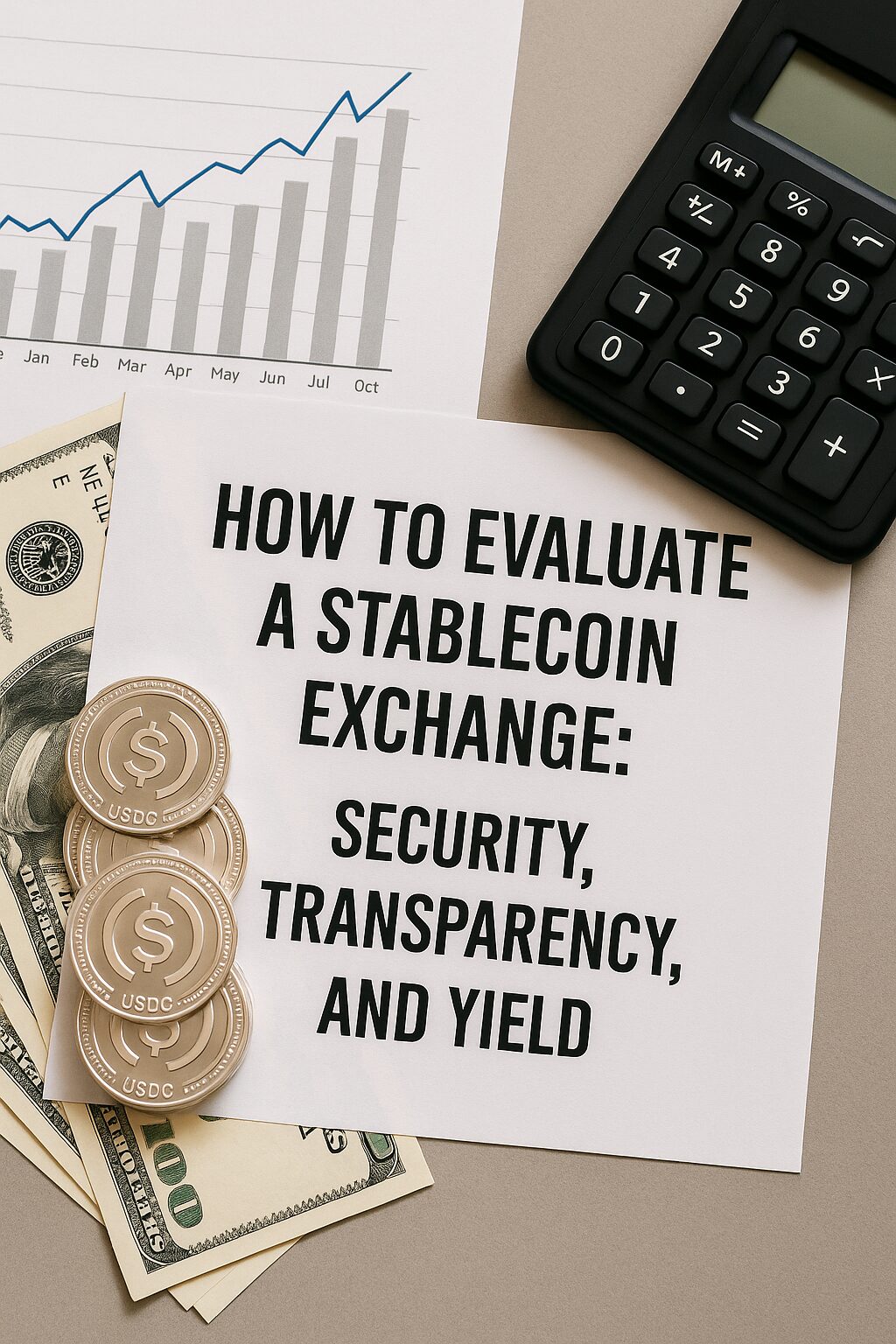With hundreds of stablecoin exchanges now available, choosing the right one can feel overwhelming. From flashy interest rates to complicated legal structures, many platforms hide risk beneath attractive interfaces.
So how do you evaluate a stablecoin exchange like a pro?
In this guide, we’ll break down a framework that helps you make informed decisions—balancing risk, return, and trust—so you can safely earn passive income with your stablecoins.
Why Evaluation Matters More Than Ever
In 2022 and 2023, we saw high-profile collapses: Celsius, BlockFi, FTX. Billions in user funds were lost—not due to crypto volatility, but due to platform failure and mismanagement.
Today’s stablecoin ecosystem is stronger, but risk remains. It’s no longer enough to chase high APYs. You must analyze the foundations of the platform itself.
The 3 Core Evaluation Pillars
To properly evaluate a stablecoin platform, focus on these three dimensions:
- Security
- Transparency
- Yield Sustainability
Let’s examine each in depth.
1. SECURITY – Can the Platform Protect Your Assets?
This is the non-negotiable starting point. No matter how high the yield, if the platform can’t secure your assets, it’s a no-go.
Checklist for Security:
Custody Model
- Who holds your funds?
- Custodial (platform holds assets) or non-custodial (you control keys)?
- Are third-party custodians like Fireblocks or BitGo involved?
Cold Wallet Storage
- What percentage of funds are kept offline?
- Platforms that store 90%+ in cold storage are safer.
Insurance Coverage
- Is there any insurance against theft, hacks, or insolvency?
- Nexo, for instance, offers up to $375M in custodial insurance.
Audit History
- Has the platform undergone security audits?
- Look for firms like CertiK, ChainSecurity, or Trail of Bits.
Incident Record
- Any past breaches?
- How did they respond? Transparency in past incidents builds trust.
2. TRANSPARENCY – Can You See What’s Happening Behind the Scenes?
Trustworthy platforms make their operations and financials visible.
Checklist for Transparency:
Public Proof of Reserves
- Does the platform publish real-time reserve data?
- Are third-party attestation or audit reports available?
Revenue Model Clarity
- How does the platform make money?
- Does it lend your assets? Use them as collateral?
Terms of Use & Risk Disclosure
- Are they clearly written and accessible?
- Look for specifics: withdrawal limits, lock-up risks, platform obligations.
Regulatory Status
- Is the platform licensed or registered anywhere?
- U.S. FinCEN, EU e-money license, or other recognitions?
Company Info & Team Visibility
- Who runs the company?
- Do team members have public profiles, LinkedIn pages, or past experience in finance or crypto?
3. YIELD – Is the Income Realistic and Sustainable?
Don’t fall for “too good to be true” rates. If something offers 30% APY on stablecoins with no clear source, run.
Checklist for Yield Evaluation:
Source of Returns
- Where does the yield come from?
- Lending? Market-making? Token incentives?
Consistency Over Time
- How stable has the APY been historically?
- Sudden spikes often indicate unsustainable models.
Compound Frequency
- Daily, weekly, or monthly compounding?
- Daily compounding (as on Nexo) increases earnings over time.
Platform Volume and TVL (Total Value Locked)
- Is there enough activity to support the promised returns?
- Low volume platforms promising high yield are red flags.
Reward in What Form?
- Are you paid in stablecoins or platform tokens?
- Token rewards are more volatile and harder to cash out.
Example: Analyzing Nexo with This Framework
| Criteria | Score | Notes |
|---|---|---|
| Security | 3 | Licensed, insured, cold wallet use |
| Transparency | 2 | Good disclosures, team visible, clear ToS |
| Yield Sustainability | 2 | APY under 10%, sourced via lending |
➡ Verdict: A balanced option with good trust signals.
Red Flags to Watch For
- No information about team or ownership
- “Guaranteed returns” language
- Rewards paid only in illiquid tokens
- Sudden UI redesigns or hiding of reserve data
- Email-only support or no response to complaints
- Unclear redemption policies or KYC loopholes
Create Your Own Evaluation Sheet
Use this 10-point checklist to score platforms out of 30:
| Category | Criteria | Points |
|---|---|---|
| Security | Custody, Cold Wallets, Audits | /10 |
| Transparency | Proof of Reserves, Team, ToS | /10 |
| Yield | Source, Stability, Token vs. Fiat | /10 |
Platforms scoring under 20 should be used with caution or not at all.
Global Considerations by Region
| Region | Key Consideration | Note |
|---|---|---|
| U.S. | Taxable income, SEC oversight | Use licensed platforms |
| EU | GDPR, MiCA compliance | Avoid anonymous DEXs |
| Asia | Exchange bans in China/Korea | Use DeFi cautiously |
| Africa | Access issues | DEXs more popular but riskier |
Always use VPN and hardware wallets when dealing across borders.
Psychological Traps to Avoid
- Chasing Yield: Don’t switch platforms just for 1–2% more return.
- Overconfidence: Even seasoned investors lost funds in Celsius.
- Complacency: Re-check platform terms every 3–6 months.
- Confirmation Bias: Don’t only read good reviews. Look for complaints.
Tools for Smarter Evaluation
- DeFiLlama: TVL stats for DeFi platforms
- Glassnode: On-chain stablecoin flows
- DappRadar: Usage metrics
- CoinGecko Earn: Compare interest rates across platforms
- Trustpilot + Reddit: Real user reviews and complaints
Final Words: Your Strategy is Your Firewall
Evaluating a stablecoin exchange is not just about finding the highest return—it’s about protecting your money while still earning.
Choose platforms that make you feel confident, not confused. Your stablecoin income should be boring, predictable, and secure.
When in doubt, diversify across 2–3 vetted platforms, hold long-term, and monitor changes.
